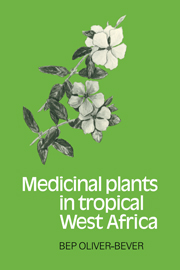Book contents
5 - Hormones of the adrenal cortex
Published online by Cambridge University Press: 04 August 2010
Summary
Introduction: the action of plants on hormone secretion in Man
A number of plant constituents can act as a substitute for natural hormones in cases of hormone deficiency. Some of these constituents have been found to be chemically identical with the natural hormone (e.g. oestrone in the kernels of date and oil palm). Other plant components have a structural similarity to the hormone (e.g. Funtumia and Holarrhena alkaloids and corticosteroids). Others again have an entirely different chemical structure (e.g. coumestans and isoflavones with oestrogenic action). All these constituents can act as a substitute for hormones and replace them in their biological functions.
Plant components often have an indirect action on the secretion of certain hormones by stimulating or inhibiting other areas like the hypothalamus and the pituitary gland which can control the function of most other glands (e.g. gonadotrophic, thyrotrophic and corticotrophic action). (For more details see Plants acting on sex hormones.) However, great precaution should be taken in using the hypothalamus–pituitary axis as a narrow interrelationship exists and often hormonal or pharmacological actions other than those desired can be obtained (Bianchi, 1962; Goodman and Gilman, 1976). Thus stimulation of lactation has been obtained with dried thyroid gland or thyroxine (Robinson, 1947; Naish, 1954), no doubt through indirect action via the pituitary gland and an impairment of the pituitary adrenal response to acute stress is observed in alloxan diabetes (Kraus, 1949).
- Type
- Chapter
- Information
- Medicinal Plants in Tropical West Africa , pp. 191 - 214Publisher: Cambridge University PressPrint publication year: 1986



